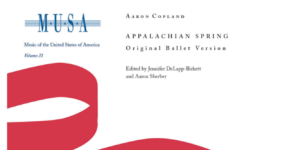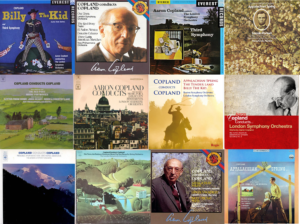
Dance Panels is virtually a Copland Greatest Hits collection! It comprises seven short contrasting pieces that showcase the many different facets of Copland’s composition style. It was originally intended to be a ballet, commissioned by Jerome Robbins. However, it was never realised in that form and instead was later developed into a concert piece.
For me it serves as a perfect companion to Statements and I’m surprised that no one has ever thought of recording them together. These two works bookend Copland’s career – Statements was one of the key works of his early 1930’s lean, abstract output whereas Dance Panels serves as the last hurrah for Copland’s more approachable Americana before the twelve tone and highly percussive pieces of the 1960s.
Dance Panels was intended as a ballet without a plot but the individual Panels themselves all have their own moods and are very evocative. If Dance Panels were to have a different name it could be Emotions. Despite having so many gorgeous episodes it is somewhat of an unknown factor to concert goers, radio listeners or CD buyers. Just like Statements it is rarely performed, played or recorded. I really don’t get it!
Perhaps, one of the reasons is that even though most of the music is original it reminds the listener of previous Copland output. Some might consider Dance Panels as being derivative of other works. I personally don’t see it like that – but instead am charmed by how such slight variations have been tailored into a rich patchwork of sound.
Here are the similarities as I see them:
Introduction: Moderato (at a moderate tempo)
The introduction is slow and moody. It reminds me somewhat of the more introspective moments from Symphony No 3. After 2:30 there is a dissonant climax followed at 2:50 by the introduction of a gorgeous motto theme led by for solo trumpet. This gives the feeling of sombre clouds forming to produce a brief heavy rain shower, a short interval of calm, followed by sunshine bursting through. This emergence of light from dark is reminiscent of the end of the first movement of the Nonet which was written at the same time and also of the piano miniature Petit Portrait.
The ethereal trumpet solo is such a familiar Copland sound that one immediately recalls Billy the Kid, Quiet City and An Outdoor Overture. But going back to Statements one might suggest that this Panel is almost like the Cryptic piece merging into the Prophetic.
Allegretto con tenerezza (Slower than allegro but in lighter style and with tenderness)
The second panel evokes the same feelings of melancholic nostalgia as Appalachian Spring, the first movement of the Clarinet Concerto and in particular Letter from Home. There’s also more than a whiff of Laurie’s song from The Tender Land – Once I thought I’d never grow with its feelings of hope and eager aspirations to go beyond the restricted horizons of her Grandfather’s Farm.
Copland suggested it should be played with “charm and delicacy, involvements, hesitations and swirlings”. At 3:12 the motto theme appears again to end this panel.
Scherzando (A quick jokey piece played joyfully)
This Panel does actually borrow directly from another piece – the Heiress film soundtrack in which the heroine Catherine Sloper tries on a cherry red dress. The falling scale played a number of times over is an approach also deployed in the first half of Symphonic Ode (listen in a 4.22 and 8.30 on the Tilson-Thomas version). Again, for me I also find a similarity with Statements – here it’s the Militant and Dogmatic that seem to be in essence. At the end of the Panel the motto theme returns again.
Pas de trois (A dance for three people)
Most of Dance Panels is set in waltz time but the Pas de Trois is the most obvious that a wannabe dancer could adequately perform the steps to. As such it could easily be likened to the cowboy waltzes from Billy the Kid and Rodeo but the elegiac mood is most similar to Paisaje Mexicano, one of Copland’s Three Latin American Sketches also composed in 1959. This might well have been in the mind of teh composer when he was drafting Dance Panels. The wistful feelings of young love set in a sepia shade are also suggestive of the film music for Our Town, particularly the scene involving George and Emily at the soda fountain. Copland directs the orchestra to play this piece “somewhat hesitant, melancholy and naïve”.
Con brio (With vivacity, spirit)
As with so many Copland works there is always room for a percussion battery and Con Brio is a real rhythmic delight that is a big shift from what has gone before. It serves a similar purpose as Gun Battle from Billy the Kid. It’s also not unlike Jingo from Statements and has a comparable ambiguous fade out ending as if the band has disappeared over a hill in the distance. Copland’s instructions are “Carefree, snappy, sharp, knowing”.
Con moto (With motion)
This is the shortest of the Panels at about 90 seconds. Copland marked the score as “menacing” and later “eloquent”. It is achingly beautiful and therefore is akin to the part for strings in the Cummington Story score later used in the Clarinet Concerto. The suggestion of possible bad tidings also makes this piece a bedfellow for Copland’s other film music e.g. Emily in Love from Our Town and Death of Candy’s Dog from Of Mice and Men.
Molto ritmico (Very rhythmic)
The final panel along with con brio is the most energetic of the pieces. It resembles the Short Symphony in its snappy rhythms and changes in direction. There is also an element of the Fear of the Night section from the full length version of Appalachian Spring. The switch to an honourable and heroic theme at 1.20 and 1.45 also remind me of the many changes in gear contained in Prairie Journal.
Copland indicates that this Panel should be played so that it is “suggesting flight and hectic emotions”. The piece builds and builds similar to the final movement of Symphony No 3 and just as the train comes to a shuddering halt in the final movement of that work, here everything reaches a crescendo (2.14) and then it dissolves back into the motto theme in “triumphant songfulness” according to Copland. The work ends with a slow fade evoking Quiet City and Music for the Theatre.
To some it might sound like a compilation – but what a compilation! All in all Dance Panels is a knock out orchestral work – one that really ought to be better known. It also deserves a persuasive choreography to exemplify the wonderful danceability of the music. Some of Copland’s other ballets are difficult to perform as the rights to the choreography are held elsewhere. Personally, I think it would make sense for dance companies to revive this Copland gem and consider making it part of their repertoire. I one day hope that this will happen and I’ll be there to see it for myself!







Leave a Comment